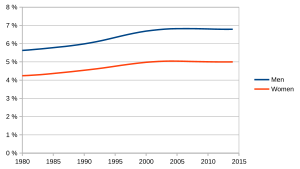
An estimated 275 Australians develop diabetes every day. The 2005 Australian AusDiab Follow-up Study (Australian Diabetes, Obesity and Lifestyle Study) showed that 1.7 million Australians have diabetes but that up to half of the cases of type 2 diabetes remain undiagnosed.
Type 2
Type 2 diabetes is the most common type of diabetes, and majority of those affected are diagnosed with Type 2. Type 2 diabetes is classified as a lifestyle disease which is impacted by environmental and hereditary factors. This form of diabetes is significantly affected by the lifestyle the individual has. It is associated with the individuals' diet and activity level. The population who are most at risk are those who adopt a sedentary lifestyle at a young age.
Prevention
- Maintaining a healthy weight
- Regular physical activity
- Managing blood pressure
- Managing cholesterol levels
- Quit/ Avoid smoking
Although there is no direct cure for Type 2 diabetes the Australian Government: Department of Health has put in place guidelines to assure that children and adolescents receive the suggested period of time engaging in physical activity. Some of their suggestions are as follows:
- shift from a low to moderate activity level
- participate in more vigorous activity rather than moderate intensity exercise- you will save time and therefore have more time for friends and family
- avoid long periods of screen time (devices including TV, Phone, etc.)
- avoid long sitting sessions
Diabetes facts
Other facts about diabetes include:
- Every year 0.8% of adults developed diabetes.
- Every day in Australia approximately 275 adults develop diabetes.
- Those with pre-diabetes were 10-20 times more likely to develop diabetes than were those with normal blood glucose levels.
- Obesity, hypertension, dyslipidaemia, physical inactivity and the metabolic syndrome each increased the risk for developing diabetes.
In 2007-08 approximately 520,000 people had diabetes and CVD meaning only 42% of diabetics did not have CVD. CVD is the major cause of mortality in people suffering from diabetes with CVD accounting for 80% of deaths.
The International Diabetes Federation has estimated that currently 194 million people worldwide, or 5.1% within the adult population have diabetes; this will jump to 333 million, or 6.3%, by 2025. Type 2 Diabetes makes up approximately 85% to 95% of all diabetes in developed countries, and is even higher in developing countries.
The European Region, with 48 million, and Western Pacific Region, with 43 million, has the most people with diabetes currently. In 2025, the region with the largest number of people with diabetes will change to the South-East Asian Region with approximately 82 million sufferers.
Right now the age group with the greatest number of people suffering from diabetes are the 40- to 59-year-olds. Owing to the ageing population, by 2025 there will be 146 million people aged 40–59 and 147 million people aged 60 or older with diabetes.
In 2003, the number of people with diabetes in urban areas was 78 million and by 2025 it is said to increase to 182 million urban and 61 million rural people with diabetes.
Epidemiology
Indigenous Australians
Main article: Diabetes in Indigenous AustraliansA University of Alberta study, conducted in 2006, noted that 60% of Aboriginal people over the age of 35 in Western Australia tested positive for diabetes.
Migrant populations
A study conducted by the International Diabetes Institute at Monash University showed that Asians, Pacific Islanders, and Middle Eastern immigrants who moved to Australia were diagnosed with diabetes at a higher level than the average. The increase was explained by the adoption of a Western diet in place of a more healthy "traditional" diet more common in their native countries, as well as adopting a more sedentary lifestyle which is ubiquitous in developed countries.
National Diabetes Services Scheme
The National Diabetes Services Scheme (NDSS) was created in 1987 and is an institution funded by the Australian Government that delivers diabetes-related products at affordable prices and provides information and support services to people with type 1, type 2, gestational and other types of diabetes; the number one national peak body for diabetes in Australia, Diabetes Australia, runs this scheme. State and territory diabetes organisations are also assisting in the arrangements and planning of services for this scheme. The National Diabetes service aim is to ensure appropriate, reliable and affordable access to diabetes-related products and services to support people suffering from diabetes.
See also
References
- "Diabetes > Data Download > NCD-RisC". ncdrisc.org. Retrieved 2020-02-08.
- "Type 2 Diabetes". Diabetes Australia. National Diabetes Services Scheme. 2015.
- "Type 2 Diabetes". Diabetes Australia. Australian Government: National Diabetes Service Scheme. 2015.
- "Australia's Physical Activity and Sedentary Behaviour Guidelines for Adults (18-64)" (PDF). Physical Activity and Sedentary Behaviour. Australian Government: Department of Health. 2014.
- ELM Barr, DJ Magliano, PZ Zimmet, KR Polkinghorne, RC Atkins, DW Dunstan, SG Murray, JE Shaw 2006, AusDiab 2005 The Australian Diabetes, Obesity and Lifestyle Study International Diabetes Institute, Melbourne, Australia
- "Cardiovascular disease". Australian Institute of Health and Welfare (AIHW). 2015. Archived from the original on 2015-04-13. Retrieved 2015-04-13.
- Sowers, J.R.; Epstein, M.; & Frohlich, E.D. (2001). "Diabetes, hypertension and cardiovascular disease an update". Journal of the American Heart Association. 37: 1053–1059. doi:10.1161/01.HYP.37.4.1053.
- "Diabetes Atlas" (PDF). 2003. Archived from the original (PDF) on 2015-09-24.
- "International study links aboriginal health, lifestyle, local decision-making". The Canadian Press. 3 July 2009. Retrieved 5 July 2009.
- Gibson, Robert. "Obesity in Australia" (PDF). Retrieved April 6, 2015.
- Gibson, Robert. "Obesity in Australia" (PDF). Retrieved April 6, 2015.
- Thompson, Madeline (7 July 2012). "The National Diabetes Services Scheme". Australian Pharmacist.